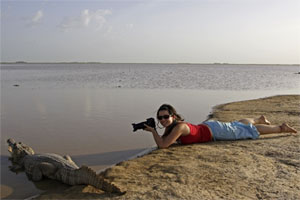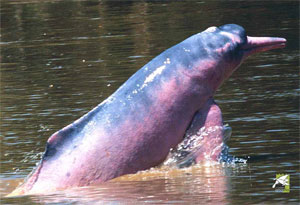 |
| Catalina Gomez-Salazar uses photo identification to document individual river dolphins. (Photo courtesy of Catalina Gomez-Salazar) |
"Shhh!" her companion advises, with a finger to his lips and a stern look that says, "don’t make a sound, not even to fend off a pesky mosquito."
Floating quietly in their canoe, draped by a blanket of trees in the Amazon River, the pair waits. Then splashes break the silence and they’re surrounded. Dolphins begin to nudge the vessel through the trees as monkey’s swing from limbs above, traveling along with them. As the canoe departs the wooded area of the river, more dolphins greet them, like new friends welcoming her, the experience of a lifetime.
Since that encounter while learning to canoe, 25 year-old Catalina Gomez-Salazar has been devoted to studying and working with river dolphins and is now a Ph.D student in Biology at Â鶹´«Ă˝.
“It was an incredible experience,” recalls Ms. Gomez-Salazar, born and raised in Colombia. “That’s when I knew I wanted to study river dolphins.”
As a student at the University of Los Andes in Bogotá, Colombia, she began working with the Omacha Foundation, a non-governmental, non-profit organization dedicated to the research and protection of fauna and aquatic ecosystems in Colombia. She is now leading a research program with the foundation, estimating the endangered river dolphin population in the Amazon and Orinoco River Basins of South America.
 |
| River dolphins are grey when they're born and acquire pink pigmentation as they age. (Photo courtesy of Catalina Gomez-Salazar) |
“Dolphins are an umbrella species,” she explains. “We think you can monitor the health of the ecosystem by monitoring the dolphins,” she adds. “Because dolphins are a charismatic species, people feel strongly about saving them.”
Ms. Gomez-Salazar’s research involves photo-identification, a method of using pictures to identify each dolphin. “The dolphins all look different,” she says. She explains each dolphin has a different pigmentation and many have scars from encounters with fishermen, boat and fights.
“With photo-identification we can try to understand the social behaviour of the dolphins because we can track them after we photograph them,” explains Ms. Gomez-Salazar.
Her work has also made her an avid photographer. “You have to take a lot of pictures for the research,” she says. “I began to enjoy it and it’s a good way to remember everything I’m doing and seeing.”
The reputation of Dr. Hal Whitehead, a professor in the Department of Biology, and his research with marine mammals drew her to Â鶹´«Ă˝. “Dr. Whitehead already had a lot of information about dolphins and I knew I could advance my research best by working and learning from him,” she says.
River dolphins are endangered because of loss of habitat, hunting for use as bait and because of conflict with fisherman. Otherwise known as Inia, river dolphins are grey when born, and get a pink pigmentation as they age. They have large foreheads and long beaks with large pectoral fins like paddles and a very small dorsal fin. They can also turn their heads to each side like humans, necessary for entering forests when the water level rises.
In addition to tracking dolphins in South America and studying at Â鶹´«Ă˝ in Halifax, she works with colleagues from the Omacha Foundation on a dolphin-adoption program. Anyone can sponsor a dolphin and receive pictures, information and updates.
“They can even come and stay at the foundation and go out with a researcher to try to see their dolphin."
LINKS: Omacha Foundation | |
